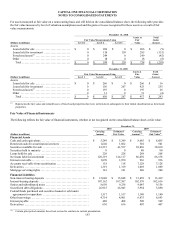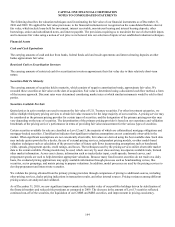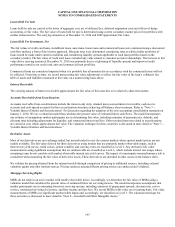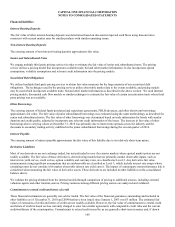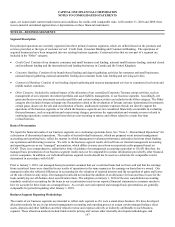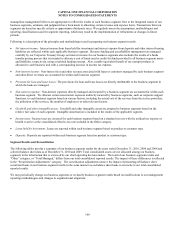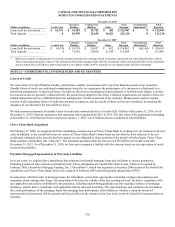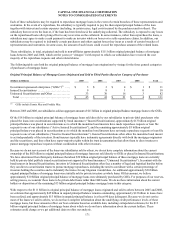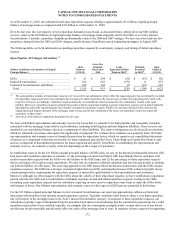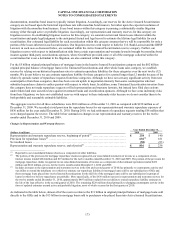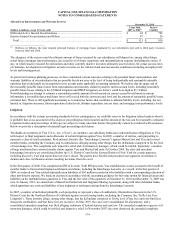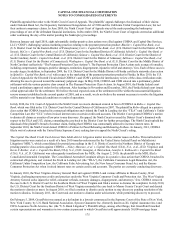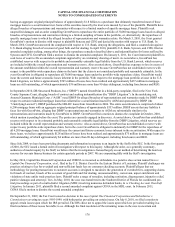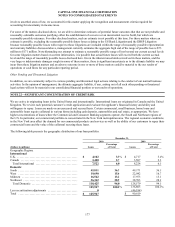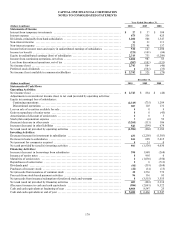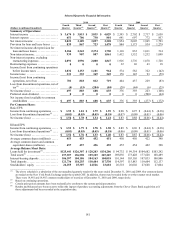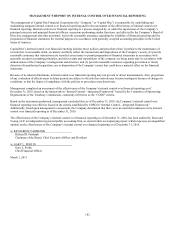Capital One 2010 Annual Report Download - page 192
Download and view the complete annual report
Please find page 192 of the 2010 Capital One annual report below. You can navigate through the pages in the report by either clicking on the pages listed below, or by using the keyword search tool below to find specific information within the annual report.
CAPITAL ONE FINANCIAL CORPORATION
NOTES TO CONSOLIDATED STATEMENTS
172
As of December 31, 2010, the subsidiaries had open repurchase requests relating to approximately $1.6 billion original principal
balance of mortgage loans as compared with $1.0 billion as of December 31, 2009.
Over the last year, the vast majority of new repurchase demands received and, as discussed below, almost all of our $816 million
reserves, relate to the $24 billion of original principal balance of mortgage loans originally sold to the GSEs or to Active Insured
Securitizations. Currently, repurchase demands predominantly relate to the 2006 and 2007 vintages. We have received relatively few
repurchase demands from the 2008 and 2009 vintages, mostly because GreenPoint ceased originating mortgages in August 2007.
The following tables set forth information on pending repurchase requests by counterparty category and timing of initial repurchase
request:
Open Pipeline All Vintages (all entities) (1)
(Dollars in millions) (All amounts are Original
Principal Balance)
Open
Claims at
12/31/09
Gross New
Demands
Received in
2010
Loans
Repurchased/Made
Whole in 2010(2)
Demands
Rescinded
in 2010(2)
Open
Claims at
12/31/10
GSEs .........................................
.
$ 61 $ 204 $ (52) $ (87) $ 126
Insured Securitizations .........................
.
366 645 (179) 0 832
Uninsured Securitizations and Others ............
.
588 104 (5) (22) 665
Total ........................................
.
$ 1,015 $ 953 $ (236) $ (109) $ 1,623
________________________
(1) The open pipeline includes all repurchase requests ever received by our subsidiaries where either the requesting party has not formally rescinded
the repurchase request and where our subsidiary has not agreed to either repurchase the loan at issue or make the requesting party whole with
respect to its losses. Accordingly, repurchase requests denied by our subsidiaries and not pursued by the counterparty remain in the open
pipeline. Moreover, repurchase requests submitted by parties without contractual standing to pursue repurchase requests are included within the
open pipeline unless the requesting party has formally rescinded its repurchase request. Finally, the amounts reflected in this chart are the
original principal balance amounts of the mortgage loans at issue and do not correspond to the losses our subsidiary would incur upon the
repurchase of these loans.
(2) Activity in 2010 relates to repurchase demands from all years.
We have established representation and warranty reserves for losses that we consider to be both probable and reasonably estimable
associated with the mortgage loans sold by each subsidiary, including both litigation and non-litigation liabilities. These reserves are
reported in our consolidated balance sheets as a component of other liabilities. The reserve-setting process relies heavily on estimates,
which are inherently uncertain, and requires the application of judgment. We evaluate these estimates on a quarterly basis. We build
our representation and warranty reserves through the provision for repurchase losses, which we report in our consolidated statements
of income as a component of non-interest income for loans originated and sold by Chevy Chase Bank and Capital One Home Loans
and as a component of discontinued operations for loans originated and sold by GreenPoint. In establishing the representation and
warranty reserves, we consider a variety of factors depending on the category of purchaser.
In establishing reserves for the $11 billion original principal balance of GSE loans, we rely on the historical relationship between GSE
loan losses and repurchase outcomes to estimate: (1) the percentage of current and future GSE loan defaults that we anticipate will
result in repurchase requests from the GSEs over the lifetime of the GSE loans; and (2) the percentage of those repurchase requests
that we anticipate will result in actual repurchases. We also rely on estimated collateral valuations and loss forecast models to estimate
our lifetime liability on GSE loans. This reserving approach to the GSE loans reflects the historical interaction with the GSEs around
repurchase requests. The GSEs have stronger contractual rights than non-GSE counterparties because GSE contracts typically do not
contain prompt notice requirements for repurchase requests or materiality qualifications to the representations and warranties.
Moreover, although we often disagree with the GSEs about the validity of their repurchase requests, we have established a negotiation
pattern whereby the GSEs and our subsidiaries continually negotiate around individual repurchase requests, leading to the GSEs
rescinding some repurchase requests and our subsidiaries agreeing in some cases to repurchase some loans or make the GSEs whole
with respect to losses. Our lifetime representation and warranty reserves with respect to GSE loans are grounded in this history.
For the $13 billion original principal balance in Active Insured Securitizations, our reserving approach also reflects our historical
interaction with monoline bond insurers around repurchase requests. Typically, monoline bond insurers allege a very high repurchase
rate with respect to the mortgage loans in the Active Insured Securitization category. In response to these repurchase requests, our
subsidiaries typically request information from the monoline bond insurers demonstrating that the contractual requirements for a valid
repurchase request have been satisfied, typically, for example, that the counterparty promptly notify us upon discovery of any breach
and that any breach materially and adversely affect the value of the mortgage loan at issue. In response to these requests for supporting



